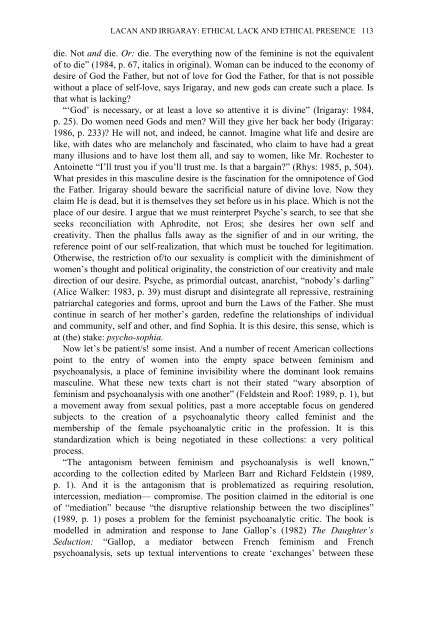Nothing Mat(t)ers: A Feminist Critique of Postmodernism
Nothing Mat(t)ers: A Feminist Critique of Postmodernism
Nothing Mat(t)ers: A Feminist Critique of Postmodernism
You also want an ePaper? Increase the reach of your titles
YUMPU automatically turns print PDFs into web optimized ePapers that Google loves.
LACAN AND IRIGARAY: ETHICAL LACK AND ETHICAL PRESENCE 113<br />
die. Not and die. Or: die. The everything now <strong>of</strong> the feminine is not the equivalent<br />
<strong>of</strong> to die” (1984, p. 67, italics in original). Woman can be induced to the economy <strong>of</strong><br />
desire <strong>of</strong> God the Father, but not <strong>of</strong> love for God the Father, for that is not possible<br />
without a place <strong>of</strong> self-love, says Irigaray, and new gods can create such a place. Is<br />
that what is lacking<br />
“‘God’ is necessary, or at least a love so attentive it is divine” (Irigaray: 1984,<br />
p. 25). Do women need Gods and men Will they give her back her body (Irigaray:<br />
1986, p. 233) He will not, and indeed, he cannot. Imagine what life and desire are<br />
like, with dates who are melancholy and fascinated, who claim to have had a great<br />
many illusions and to have lost them all, and say to women, like Mr. Rochester to<br />
Antoinette “I’ll trust you if you’ll trust me. Is that a bargain” (Rhys: 1985, p, 504).<br />
What presides in this masculine desire is the fascination for the omnipotence <strong>of</strong> God<br />
the Father. Irigaray should beware the sacrificial nature <strong>of</strong> divine love. Now they<br />
claim He is dead, but it is themselves they set before us in his place. Which is not the<br />
place <strong>of</strong> our desire. I argue that we must reinterpret Psyche’s search, to see that she<br />
seeks reconciliation with Aphrodite, not Eros; she desires her own self and<br />
creativity. Then the phallus falls away as the signifier <strong>of</strong> and in our writing, the<br />
reference point <strong>of</strong> our self-realization, that which must be touched for legitimation.<br />
Otherwise, the restriction <strong>of</strong>/to our sexuality is complicit with the diminishment <strong>of</strong><br />
women’s thought and political originality, the constriction <strong>of</strong> our creativity and male<br />
direction <strong>of</strong> our desire. Psyche, as primordial outcast, anarchist, “nobody’s darling”<br />
(Alice Walker: 1983, p. 39) must disrupt and disintegrate all repressive, restraining<br />
patriarchal categories and forms, uproot and burn the Laws <strong>of</strong> the Father. She must<br />
continue in search <strong>of</strong> her mother’s garden, redefine the relationships <strong>of</strong> individual<br />
and community, self and other, and find Sophia. It is this desire, this sense, which is<br />
at (the) stake: psycho-sophia.<br />
Now let’s be patient/s! some insist. And a number <strong>of</strong> recent American collections<br />
point to the entry <strong>of</strong> women into the empty space between feminism and<br />
psychoanalysis, a place <strong>of</strong> feminine invisibility where the dominant look remains<br />
masculine. What these new texts chart is not their stated “wary absorption <strong>of</strong><br />
feminism and psychoanalysis with one another” (Feldstein and Ro<strong>of</strong>: 1989, p. 1), but<br />
a movement away from sexual politics, past a more acceptable focus on gendered<br />
subjects to the creation <strong>of</strong> a psychoanalytic theory called feminist and the<br />
memb<strong>ers</strong>hip <strong>of</strong> the female psychoanalytic critic in the pr<strong>of</strong>ession. It is this<br />
standardization which is being negotiated in these collections: a very political<br />
process.<br />
“The antagonism between feminism and psychoanalysis is well known,”<br />
according to the collection edited by Marleen Barr and Richard Feldstein (1989,<br />
p. 1). And it is the antagonism that is problematized as requiring resolution,<br />
intercession, mediation— compromise. The position claimed in the editorial is one<br />
<strong>of</strong> “mediation” because “the disruptive relationship between the two disciplines”<br />
(1989, p. 1) poses a problem for the feminist psychoanalytic critic. The book is<br />
modelled in admiration and response to Jane Gallop’s (1982) The Daughter’s<br />
Seduction: “Gallop, a mediator between French feminism and French<br />
psychoanalysis, sets up textual interventions to create ‘exchanges’ between these

















